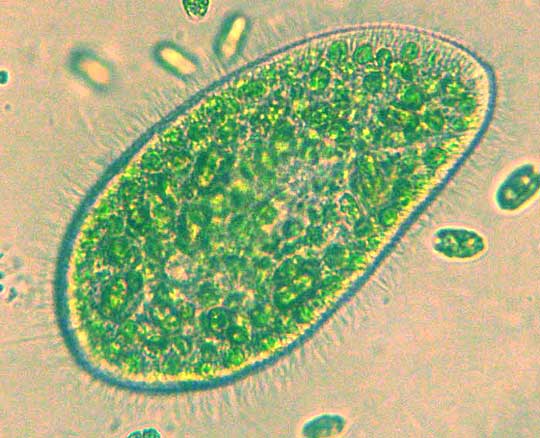Excerpts from Jim Conrad's
Naturalist Newsletter
from the February 9, 2014 Newsletter issued from the Frio Canyon Nature Education Center in the valley of the Dry Frio River in northern Uvalde County, southwestern Texas, on the southern border of the Edwards Plateau; elevation ~1750m (~5750 ft); N29.62°, W99.86°; USA
GREEN PARAMECIUM
In a fishbowl of Dry Frio River water on the windowsill a diffuse blob of greenness about the size of a mouse's eye floated at the water's surface. The blob proved to consist of millions of one-celled, greenish, highly mobile organisms. Beneath the microscope, amidst this galaxy of shifting green points appeared a much larger, egg-shaped being, like a lumbering elephant in a field of nervous rabbits. Below, you can see the whole thing, with the elephantine blob being about 0.13mm long:

With its body enveloped in hairlike cilia, this has to be a ciliate protozoan. Doing an image search on the keywords "freshwater ciliate protozoans," I was surprised when a match turned up under the name PARAMECIUM BURSARIA, sometimes known as the Green Paramecium. I thought I knew the paramecium pretty well, having been introduced to it back in high school in the 1960s, as an example of a one-celled animal that reproduced by "conjugation." But the paramecium I remembered was more slender, especially at the top, and wasn't at all green.
My high school paramecium had been Paramecium caudatum, so it had been a different species. Our current Paramecium bursaria is in some ways much more interesting. It also undergoes conjugation -- where compatible mating types get side-by-side and exchange genetic material -- but its amazing feature is the presence of those green items inside it.
Each of those green items is a one-celled green alga called Zoochlorella. In the wild sometimes Paramecium bursaria containing no Zoochlorella can be found, but most do have them, and the Zoochlorella seem to like the arrangement, for they reside within numerous protozoan and invertebrate species other than Paramecium bursaria. However, Paramecium bursaria is the only algae-hosting paramecium.
It's a classic symbiotic relationship: The algae occupy the paramecium cell's fluid contents -- its cytoplasm -- providing the cell with photosynthesized food, while the paramecium provides the algae with movement and protection, as well as nitrogen and carbon dioxide. It's been shown that algae-bearing Paramecium bursaria can grow better than those not containing algae.
Paramecia in general feed on micro-organisms like bacteria, algae, and yeasts. Their cilia sweep food and water into the cell mouth, the food continues into the gullet, and when enough food has collected at the gullet's bottom it breaks away and forms a food vacuole -- a little bubble of food that drifts throughout the cell. As it moves about, enzymes from the cytoplasm enter the vacuole and digest it. The digested food then diffuses into the cytoplasm as the vacuole grows smaller and smaller. When the vacuole reaches the anal pore the remaining undigested waste is removed.
Paramecia no longer are regarded as one-celled animals. During most of my life they've been regarded as members of the Kingdom Protista, whose members often have little in common with one another besides their being very small and simply organized. Protista is still recognized by many specialists, but now some experts assign paramecia to the newly erected Kingdom Chromalveolata. This kingdom already is drawing fire because it seems to embrace several unrelated groups.
In other words, science can't really make up its mind what kind of being Paramecium is, and having Paramecium bursaria with algae living inside it probably doesn't make understanding them any easier.
Paramecium bursaria commonly occupies many freshwater habitats in North America and Eurasia, and possibly elsewhere.